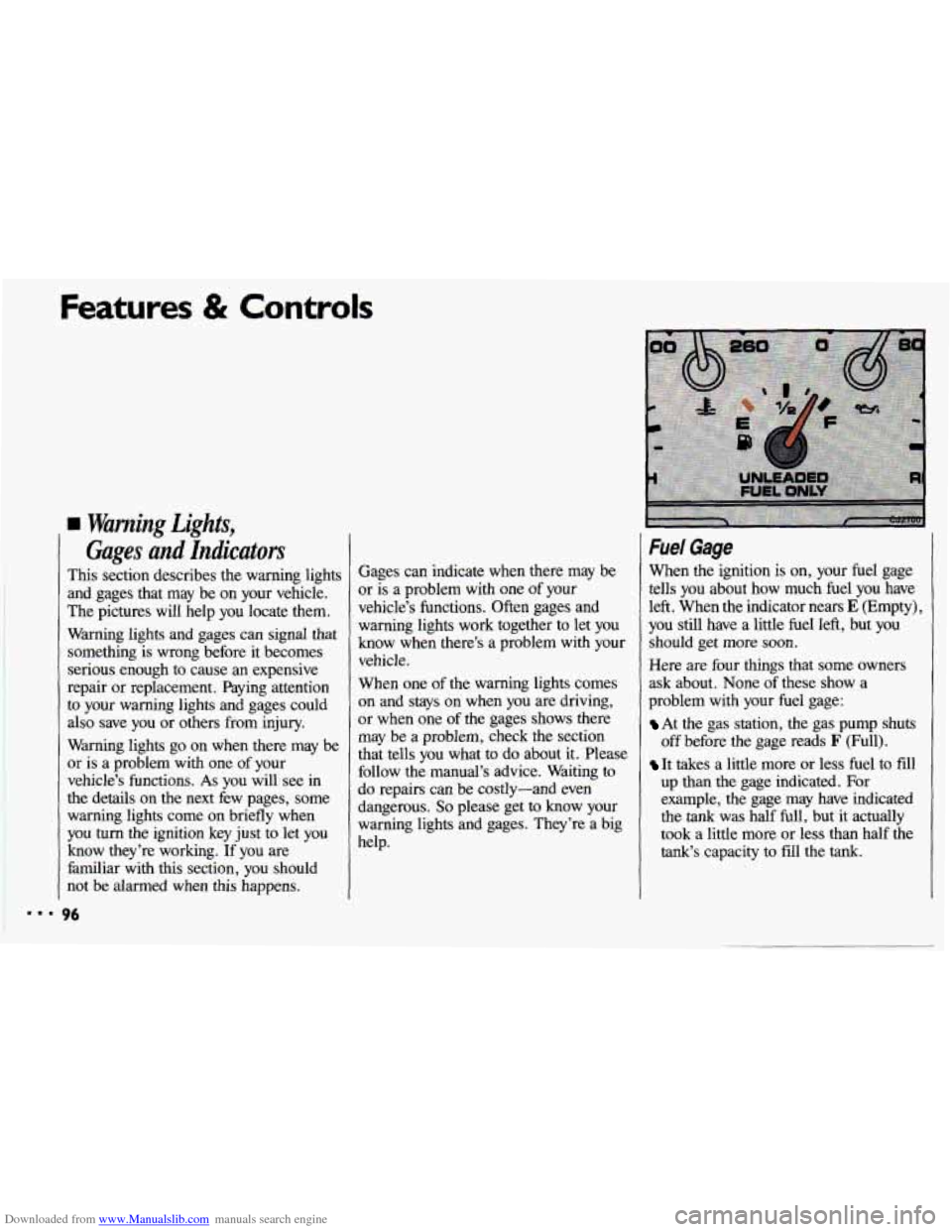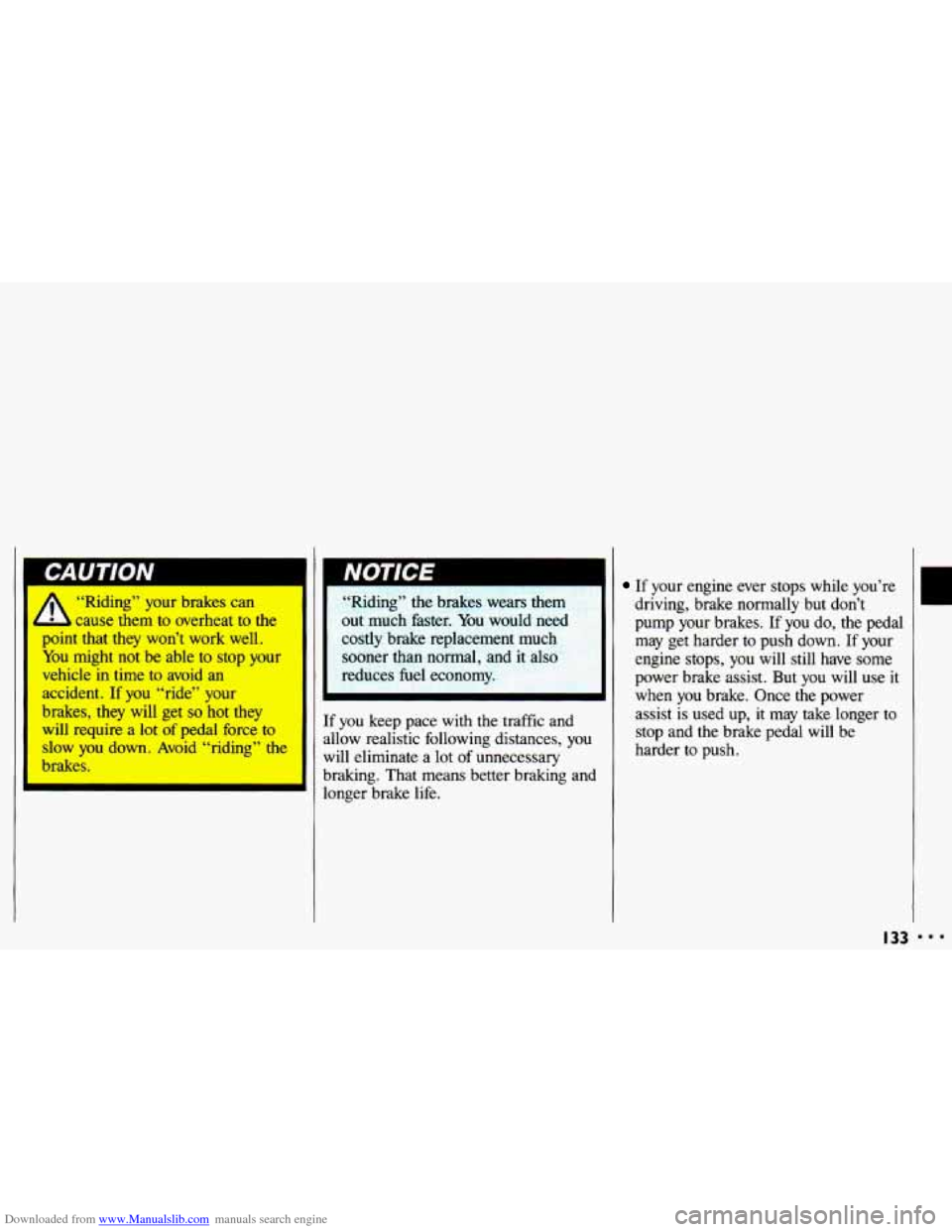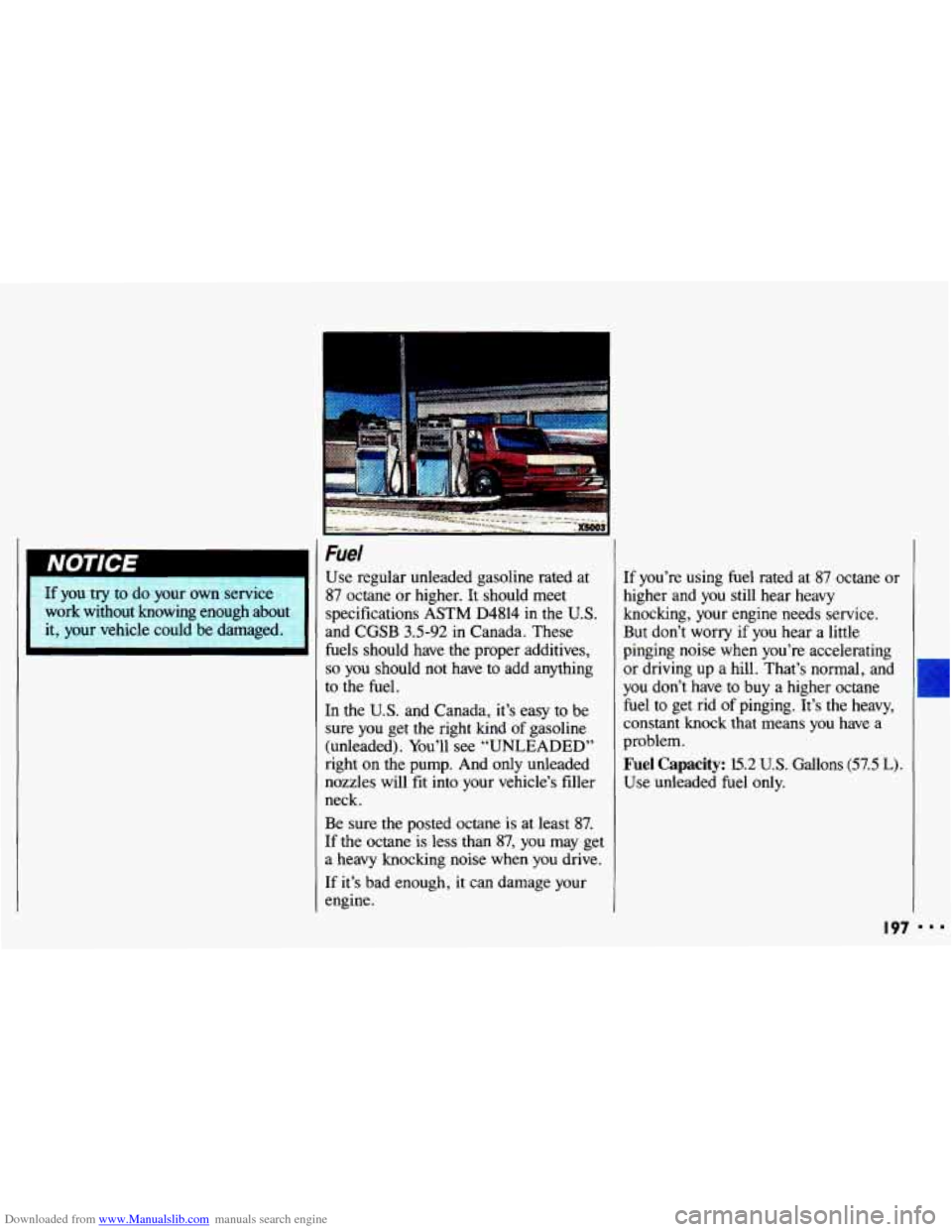Page 98 of 308

Downloaded from www.Manualslib.com manuals search engine Features & Controls
Warning Lights,
Gages and Indicators
This section describes the warning lights
and gages that may be on your vehicle.
The pictures will help
you locate them.
Warning lights and gages can signal that something is wrong before it becomes
serious enough
to cause an expensive
repair or replacement. Paying attention
to your warning lights and gages could also save you or others from injury.
Warning lights
go on when there may be
or is a problem
with one of your
vehicle’s functions.
As you will see in
the details on the next few pages, some
warning lights come on briefly when
you turn the ignition key just to let you
know they’re working. If you are
familiar with this section, you should
not be alarmed when this happens. Gages can indicate when there
may be
or is a problem with one
of your
vehicle’s functions. Often gages
and
warning lights work together to let you
know when there’s a problem with your
vehicle.
When one of the warning lights comes
on and stays on when you are driving,
or when one
of the gages shows there
may be a problem, check the section
that tells you what to do about it. Please
follow the manual’s advice. Waiting to
do repairs can be costly-and even
dangerous.
So please get to know your
warning lights and gages. They’re a big
help.
Fuel Gage
When the ignition is on, your fuel gage
tells
you about how much fuel you have
left. When the indicator nears
E (Empty),
you still have a little fuel left, but you
should get more soon.
Here are four things that some owners
ask about. None
of these show a
problem with your fuel gage:
At the gas station, the gas pump shuts
off before the gage reads
F (Full).
It takes a little more or less fuel to fdl
up than the gage indicated. For
example, the gage may have indicated
the
tank was half full, but it actually
took a little more or less than half the
tank‘s capacity to fill the tank.
Page 135 of 308

Downloaded from www.Manualslib.com manuals search engine “Riding” your brakes can
cause them to averheat to the
point that they won’t work well.
You
might not be able to stop your
vehicle
in time to avoid an
accident. If you “ride” your
brakes,
they will get so hot they
slow you down. Avoid “riding” the
brakes.
I
will require a lot of pedal force to
‘‘Riding” the brakes wears them
out much faster. You would neec
costly brake replacement much
sooner than normal, and it also
reduces fuel economy.
If you keep pace with the traffic and
allow realistic following distances, you
will eliminate a lot of unnecessary
braking. That means better braking
and
longer brake life.
If your engine ever stops while you’re
driving, brake normally but don’t
pump your brakes.
If you do, the pedal
may get harder to push down.
If your
engine stops, you will still have some
power brake assist.
But you will use it
when you brake. Once the power
assist is used up,
it may take longer to
stop and the brake pedal will be
harder to push.
Page 199 of 308

Downloaded from www.Manualslib.com manuals search engine If you try to do your own servic
work without knowing enough abot it, your vehicle could be damaged.
Fuel
Use regular unleaded gasoline rated at
87 octane or higher. It should meet
specifications ASTM D4814 in the U.S.
and CGSB
3.5-92 in Canada. These
fuels should have the proper additives,
so you should not have to add anything
to the fuel.
In the U.S. and Canada, it’s easy to be
sure you get the right kind
of gasoline
(unleaded). You’ll see “UNLEADED”
right on
the pump. And only unleaded
nozzles will
fit into your vehicle’s filler
neck.
Be sure the posted octane is at least
87.
If the octane is less than 87, you may get
a heavy knocking noise when you drive.
If it’s bad enough, it can damage your
engine.
If you’re using fuel rated at 87 octane or
higher and
you still hear heavy
knocking, your engine needs service.
But don’t worry
if you hear a little
pinging noise when you’re accelerating
or driving up
a hill. That’s normal, and
you don’t have to buy a higher octane
fuel to get rid of pinging. It’s the heavy,
constant knock that means
you have a
problem.
Fuel Capacity: 15.2 U.S. Gallons (57.5 L).
Use unleaded fuel only.
I97
Page 250 of 308
Downloaded from www.Manualslib.com manuals search engine Service & Appearance Care
Fuse Usage
Fuse Rating
(AMP.)
INSTLPS 5
ECM 10
CIG 15
RADIO2 10
GAUGES 10
PK/TURN HTR-AIC
WIPER
F/P
RADIO 1
CTSY
WINDOW CRUISE
TURN-BIU
S/LP FTP
ACC
HDLP
15
25
25
10
10
20
30
10
15
20
20
30
20
Circuitry
Instrument Panel Lamps
Electronic Control Module, Fuel Injectors Cigarette Lighter, Glove
Box Light
Radio Power Gauges, Audible Warning System, Cluster Telltales, TCC, Rear
Defogger Relay, Brake Transaxle Shift Interlock, Multiport Fuel
Injection
Park and Turn Lamps
Heater and A/C Power, Daytime Running Lights (Canada),
Anti-Lock Brakes
Windshield Wipers
Fuel Pump
Radio Memory, Digital Clock
Interior Lights, Horn, Power Locks, Audible Warning System,
Remote Liftgate Release, Check Oil Light
Power Window (Breaker)
Cruise Control
Turn Signal, Back-up Lamps Stop Lamps, Hazard Flashers
Flash-To-Pass
Power Locks, Rear Window Defogger (Breaker)
Headlamp (Breaker)
248
Page 253 of 308
Downloaded from www.Manualslib.com manuals search engine Refrigerant, Air Conditioning. .......................... See refrigerant charge label under hood.
Not all air conditioning refrigerants are the same. If the air
conditioning system in
your vehicle needs refrigerant, be sure
the proper refrigerant is used.
If you 're not sure, ask your
Chmrolet dealer.
Fuel Tank ........................................... 15.2 gallons
Power Steering
Pump Only ......................................... 1 .OO pint
Complete System
.................................... 2.25 pints
57.5 L
0.50 L
1.25 L
Tire Pressures, Sizes. .................................. See Tire-Loading Information label on driver's door.
Wheel Nut Torque .................................... 100 pound-feet (140 Nem)
NOTE: All capacities are approximate. When adding, be sure
to fill to the appropriate level, as recommended in this manual.
25 I